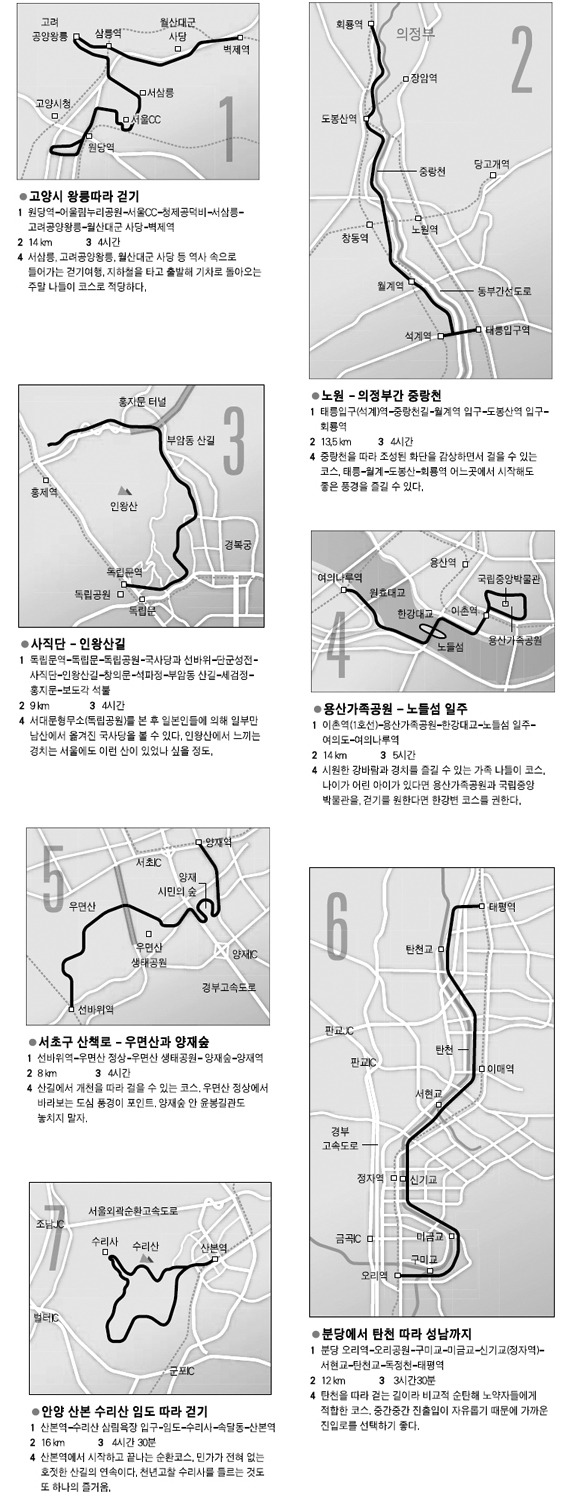"All things are bound together by order, and this is form, which brings the universe into the likeness of God."
-Dante
"All things are bound together by order, and this is form, which brings the universe into the likeness of God."
-Dante
해변의 몸짱…걷기로 지금부터 준비하세요


| Leisure l 나들이][1년 52주 주말 걷기] [1월 둘째주] 북악스카이웨이 산책로~홍지문 • ‘북악’ 아래 길이 있어 걸어보니… 여기가 진짜 서울인가 |
 발행일 : 2007.01.11 / 주말매거진 D6 면 발행일 : 2007.01.11 / 주말매거진 D6 면  기고자 : 설호규 기고자 : 설호규 |
The Russian philologist and literary philosopher M.M. Bakhtin used the term chronotope to designate the spatio-temporal matrix which governs the base condition of all narratives and other linguistic acts. The term itself can be literally translated as "time-space".
Bakhtin scholars Caryl Emerson and Michael Holquist state that the chronotope is 'a unit of analysis for studying language according to the ratio and characteristics of the temporal and spatial categories represented in that language'. Specific chronotopes are said to correspond to particular genres, or relatively stable ways of speaking, which themselves represent particular worldviews or ideologies. To this extent, a chronotope is both a cognitive concept and a narrative feature of language.
The distinctiveness of chronotopic analysis, in comparison to most other uses of time and space in language analysis, stems from the fact neither time nor space is privileged by Bakhtin, they are utterly interdependent and they should be studied in this manner.
Linguistic anthropologist Keith Basso invoked "chronotopes" in discussing Western [Apache] stories linked with places. At least in the 1980s when Basso was writing about the stories, geographic features reminded Western Apaches of "the moral teachings of their history" by recalling to mind events that occurred there in important moral narratives. By merely mentioning "it happened at [the place called] 'men stand above here and there,'" storyteller Nick Thompson could remind locals of the dangers of joining "with outsiders against members of their own community." Geographic features in the Western Apache landscape are chronotopes, Basso says, in precisely the way Bakhtin defines the term when he says they are “points in the geography of a community where time and space intersect and fuse. Time takes on flesh and becomes visible for human contemplation; likewise, space becomes charged and responsive to the movements of time and history and the enduring character of a people. . .. Chronotopes thus stand as monuments to the community itself, as symbols of it, as forces operating to shape its members' images of themselves” (1981:84, as cited by Basso 1984:44-45).
M.M. Bakhtin (1981) 'The Dialogic Imagination: Four Essays by M.M. Bakhtin', translated by Caryl Emerson & Michael Holquist, University of Texas Press
K. Basso (1984) 'Stalking with Stories: Names, Places, and Moral Narratives among the Western Apache.' In E. Bruner, ed. Text, Play and Story. Proceedings of the American Ethnological Society.
Also of interest is Joseph Frank's essay 'Spatial Form in Modern Literature', Sewanee Review, 1945, Vol. 2-3
 |
From Renaissance to Baroque Historians of instruments and instrumental music have long recognized that there was a period of profound change in the seventeenth century, when the consorts or families of instruments developed during the Renaissance were replaced by the new models of the Baroque period. This book will appeal to performers, instrument makers and academics with an interest in achieving a better understanding of this process of change from the 'Renaissance' to the 'Baroque'. more... | |
| Music and Historical Critique: Selected Essays Gary Tomlinson Series: Ashgate Contemporary Thinkers on Critical Musicology
Music and Historical Critique provides a definitive collection of Gary Tomlinson's influential studies on critical musicology, with the watchword throughout being history. This collection gathers his most innovative essays and lectures, some of them published here for the first time, along with an introduction outlining the context of the contributions and commenting on their aims and significance. Music and Historical Critique provides a retrospective view of the author's achievements in bringing to the heart of musicological discourse both deep-seated experiences of the past and meditations on the historian's ways of understanding them. |
 |
Critical Musicology and the Responsibility of Response Selected Essays Lawrence Kramer Series: Ashgate Contemporary Thinkers on Critical Musicology
Why does music move us? Lawrence Kramer suggests we should ask this old question in a different way: what is responsible for our response to music, and to what is our response responsible? The essays in this outstanding collection try to answer this question amongst many others, and by finding cultural meaning in music they exemplify the critical turn in musicology. Sixteen essays have been selected, most of them previously published, from the late 1980s to the present day. These are prefaced by an excellent introduction which traces the intellectual development of critical musicology and discusses the part these essays have had to play in that movement. |